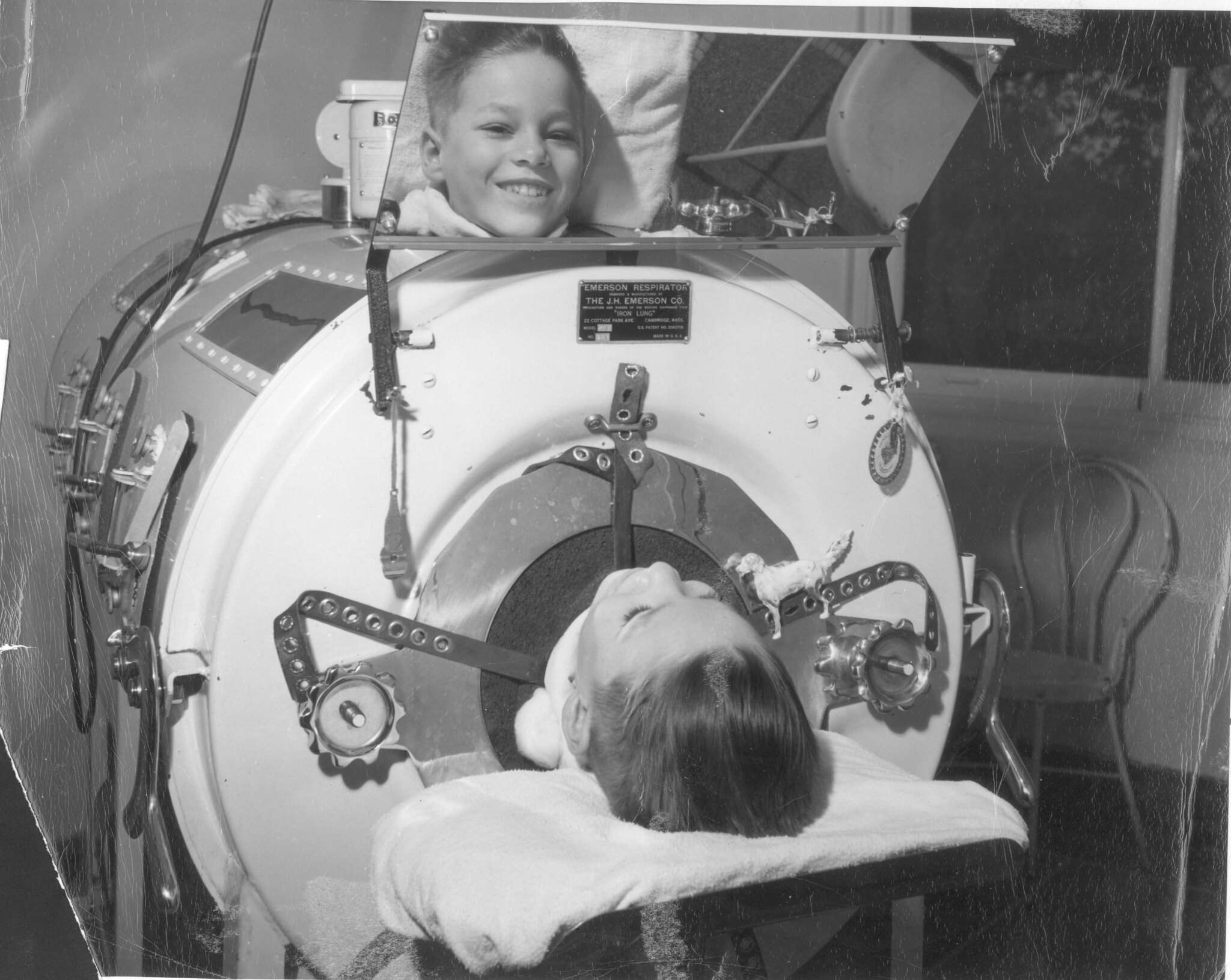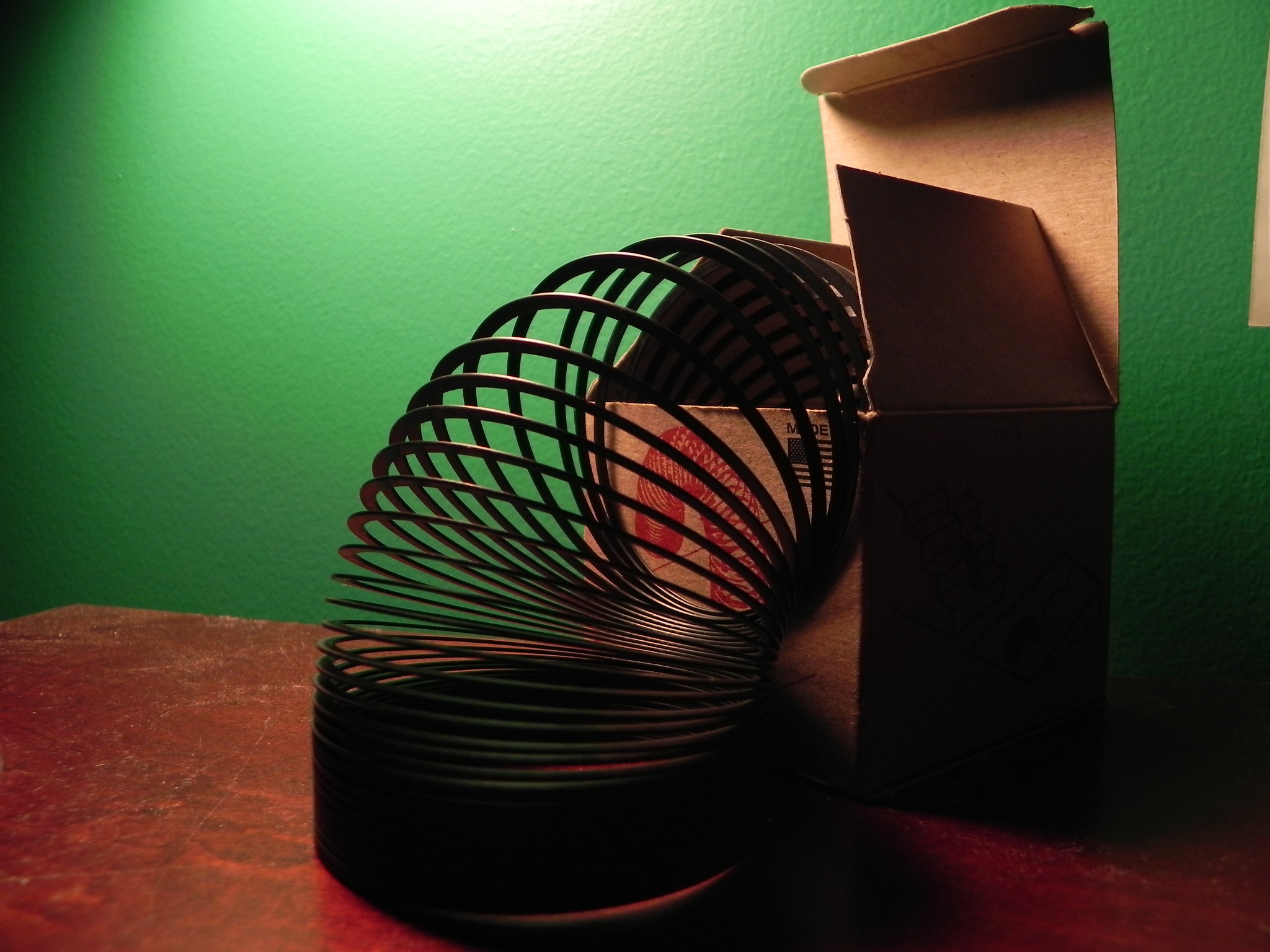Flash Essay by Kenneth Michael Stewart
From Sickness to Health in an Iron Lung

Pain is not something we remember well, but it does keep us from precisely noticing anything else. Long ago in September, just after the start of fourth grade, my temperature was 103 degrees or more. I had an extreme headache. At the same time, the muscles in the back of my neck ached—except “ached” means a dull pain, and this pain was definitely not dull. My only escape was sleep.
I had polio. For me, nine years old in the fall of 1952, it felt like a very bad flu that lasted for weeks. Then I had to deal with the aftermath.
When I began to feel better, I realized I was in an iron lung to help my breathing. I have no memory of a breathing problem, just the swooshing sound of the strange contraption.
Polio causes affected muscles to spasm and tighten, akin to a night-time charley horse. I now know that the polio vaccine was introduced in 1955—but 1952 was an “epidemic” year in the US, according to the History channel’s “This Day in History” site. There were 58,000 new cases of polio that year, many of them children, and more than 3,000 people died.
I recovered in what was known as the Isolation Hospital, which at the time was part of and behind John Gaston Hospital in Memphis, Tennessee. (John Gaston and the Isolation Hospital were demolished in 1990.) My parents never discussed the details of my experience with me, and my memory is patched together with research done decades later. I’m pretty sure we learned about iron lungs in school, and even as a kid, I was interested in science. I wanted to know how things worked. But the detail that stands out is this: After returning home, I learned my grandmother had burned my comic book collection because polio was considered so contagious.
The iron lung was a metal tube approximately six feet long and four feet in diameter. The tube was horizontal and could be rolled around the room. It looked much like a one-man submarine with portholes on the side. One end was covered with an airtight rubber membrane. A motor was attached that moved this membrane in and out. I later learned that the speed of the motor was set to mimic human breathing.
The other end of the tube was covered with a metal disk that resembled a trashcan lid. This lid had a hole in the center large enough to get my head through. On the outside part was a supporting pillow. Attached to the other side was a bed inside the tube. This entire section of the iron lung (pillow, lid, bed) was on wheels. A collar around my neck—I remember it as tough and sponge-like—made the inside of the lung airtight.
I understand now that as the air pressure inside the tube fell and rose, air flowed into and out of my own lungs.
The iron lung could be opened and closed. This was regularly necessary for the insertion and removal of a cold metal bedpan. My shyness made this excruciating. The portholes also let the nurses see inside, allowing them to move my bed coverings and do many things I didn’t want them to do.
There was a mirror above my head—I could see the nurses and others gathered—and a lectern-like support where an open book could be laid. I could read a couple of pages, but then I’d have to ask a nurse (or, if she were there, my mother) to turn the page.
I could get a finger under the sponge collar; otherwise, I would have strangled. I could maybe scratch my chin. I quickly discovered that nothing makes a nose itch like not being able to scratch it.
The Isolation Hospital owned many long strips of wool. I’d always hated wool. A shirt with any wool in it made my skin itch. Even when I was still in the iron lung, a nurse would roll a strange-looking enclosed tub into my room. Strips of wool and gallons of water were heated together in this tub, until the water was at or near boiling. The escaping steam was obnoxious. I was allergic to wool, and it could make my skin become inflamed at its touch. The steam in my nose produced a feeling of suffocation and an odor I will never forget.
After squeezing most of the boiling water from the malodorous wool, the nurse would wrap the rags around my legs and arms. Initially, the heat was intense; I was scared, fearing permanent damage. The process seemed to go on forever, until the rags cooled, the heat penetrating and relaxing my spasming muscles. And yet, it’s not the spasms or pain I remember, only the damp, hot, itchy, smelly strips of wool, clinging to my skin.
In addition to iron lungs, the Isolation Hospital had a number of other weird contraptions. I found them all more or less disagreeable. To escape the lung, I first spent time on the rocking bed, a full-size bed that could be rotated by a motor. It was very much like a carnival ride, and I never much cared for carnival rides. First, my head would be up while my feet were down. Then my feet would be up while my head was down. The speed was synchronized with my breathing—with my head down, my stomach and other internal organs pushed on my diaphragm, forcing air out of my lungs; head up, these same organs pulled on my diaphragm, drawing air in.
The rocking bed was less efficient than the lung. Organs above the diaphragm, such as your heart, weigh almost as much as those below and so cancel most of the breathing benefits. I don't remember getting seasick, as I had feared, but I was always glad when the session was over.
To graduate from the rocking bed, I had what I called a chest vest. I remember it as being thick and attached to my chest by nylon straps tied around my back. There was a large clear blue vinyl hose attached to the front of the vest. This hose ran to an air pump with an electric motor—the whole purpose of the vest was to increase and decrease pressure periodically on my chest to help me breathe.
I’ve found few references to a “chest vest” in my research, though. I did come across a photo of a “chest respirator,” but it’s not as I remember it. In another photo, a girl, circa 1955, wears a “portable respirator” that looks similar to the vest I remember. But I also wonder if it was a figment of my imagination, something that became real in my mind because I wished for it. I do know I wanted to feel like I was making progress. By escaping the iron lung, then the rocking bed, and finally the chest vest, I would make progress toward escaping the terrible place I found myself in. I didn’t return home until March the following year.

One late night, just after Christmas, a Slinky—a metal spring-like toy that could “walk” down stairs—beckoned from a bedside chair. I knew how it worked. I had seen advertisements for it, probably in our afternoon newspaper, the Memphis Press-Scimitar. It was a gift from my mother, a gift she never would have given me if she’d recognized the danger.
I had been in the hospital for four months by then. I was lying in a regular bed. I had escaped the iron lung, and breathing was no longer a problem, but I’d missed Christmas at home. The long hallway outside my room was dark and deserted except for a single nurse, vaguely visible at her far-away station. The whole wing was dimly lit, but not pitch black. All the young patients were supposed to be sleeping.
The lamp by my bed was off but plugged into the dual electrical outlet in the wall. I wondered what would happen if I stuck the Slinky into the wall socket. I pulled the metal spiral apart and bent one end slightly to insert into the empty socket. I was stupid—but not that stupid. I used two wooden spoons to maneuver the Slinky into fateful contact.
A blinding flash. The loud smell of electrical smoke. Darkness. Distant shouting. Approaching flashlights, until finally light returned. My deed undetected, I fell asleep. Safe.
Publishing Information
- “Salk Announces Polio Vaccine” (March 26, 1953), “This Day in History,” History channel website.
- “From Emergence to Eradication: The Epidemiology of Poliomyelitis Deconstructed” by Neal Nathanson and Olen Kew, American Journal of Epidemiology, December 2010.
- “John Gaston” (“Ask Vance”) by Vance Lauderdale, Memphis Magazine, April 1, 2009.
- “Chest Vest” photos: “Whatever Happened to Polio?” (Smithsonian National Museum of American History) and “22 Strange Medical Instruments from the Past That Make You Shudder” (Gizmodo).
Art Information
- “Boy in Emerson Respirator (Iron Lung)” © Otis Historical Archives National Museum of Health and Medicine; photograph by Joe Clark; Creative Commons license.
- “Slinky” © Matías Ignacio Fernández Gaete; Creative Commons license.
 Kenneth Michael Stewart was born in Memphis, Tennessee. He pursued biology and chemistry majors before graduating with a degree in mathematics and physics. Mike joined IBM and worked on the guidance system for the Saturn V moon rocket. Later, he started his own company.
Kenneth Michael Stewart was born in Memphis, Tennessee. He pursued biology and chemistry majors before graduating with a degree in mathematics and physics. Mike joined IBM and worked on the guidance system for the Saturn V moon rocket. Later, he started his own company.
After retirement, Mike wanted to write, but not just anything. He now lives in Collierville, Tennessee, with his wife. They have a son and two grandchildren. His recent book is A Book Like No Other: Everything Is Connected (2019).
Follow Mike on Twitter @jellowriter.
